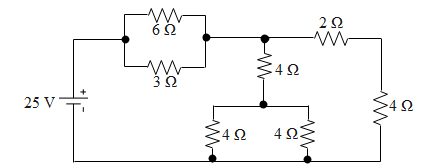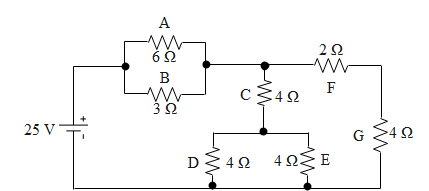
What is the current through the resistor $6\Omega $ in the circuit shown in figure

a) 10/3 A
b) 5/2 A
c) 5/3 A
d) 1/4 A

Answer
566.7k+ views
Hint: The current through any given resistor is the ratio of the potential difference to that of the resistance of the resistor. If two resistors are connected in series, then the equivalent resistance is given as the sum is their individual resistances. If two resistances are connected in parallel then the reciprocal of the equivalent resistance is given as the sum of the reciprocal of the sum of their individual resistances. Hence we will find the potential difference across the $6\Omega $ by taking the equivalent of the above circuit and using ohm's law to determine the current.
Complete answer:
When two resistances are connected in series as shown below i.e. r and R, then net resistance is given as,

$R(net)=R+r$
Similarly, when two resistances are connected in parallel as shown below i.e. r and R, then net resistance is given as,

$\begin{align}
& \dfrac{1}{R(net)}=\dfrac{1}{R}+\dfrac{1}{r} \\
& R(net)=\dfrac{R.r}{R+r} \\
\end{align}$
Now let us name all the resistance in the circuit, so that it becomes easier to determine the equivalent resistance in the circuit.

The resistances F and G are connected in series. Therefore their net resistance is,
$\begin{align}
& R(net)\left[ F+G \right]=2+4=6 \\
& R(net)\left[ F+G \right]=6\Omega \\
\end{align}$
The resistances D and E are connected in parallel. Therefore their net resistance is,
$\begin{align}
& R(net)\left[ D+E \right]=\dfrac{4.4}{4+4}=2 \\
& R(net)\left[ D+E \right]=2\Omega \\
\end{align}$
The equivalent of D and E is connected in series with C. Therefore their net resistance is,
$\begin{align}
& R(net)\left[ D+E+C \right]=2+4=6 \\
& R(net)\left[ D+E+C \right]=6\Omega \\
\end{align}$
The net resistance of F,G and D,E,C are in parallel. Therefore their net resistance is,
$\begin{align}
& \dfrac{1}{R(net)\left[ D+E+C+F+G \right]}=\dfrac{1}{R(net)\left[ F+G \right]}+\dfrac{1}{R(net)\left[ D+E+C \right]} \\
& R(net)\left[ D+E+C+F+G \right]=\dfrac{6.6}{6+6}=3 \\
& R(net)\left[ D+E+C+F+G \right]={{R}_{0}}=3\Omega \\
\end{align}$
The resistances A and B are connected in parallel. Therefore their net resistance is,
$\begin{align}
& R(net)\left[ A+B \right]=\dfrac{6.3}{6+3}=2 \\
& R(net)\left[ A+B \right]=2\Omega \\
\end{align}$
The net resistance of A,B and D,E,C F,G are in series. Therefore their net resistance is,
$\begin{align}
& R(net)=R(net)\left[ A+B \right]+{{R}_{0}} \\
& R(net)=2+3=5 \\
& R(net)=5\Omega \\
\end{align}$
Hence the net resistance in the circuit is 5 ohms. Hence using ohm's law the current in the circuit is,
$I=\dfrac{V}{R\left( net \right)}=\dfrac{25}{5}=5A$
Hence the potential difference across A and B is,
$\begin{align}
& V=IR(net)\left[ A+B \right] \\
& V=5\times 2=10V \\
\end{align}$
This is the potential difference across both the resistances A and B, therefore the current across resistor A i.e. $6\Omega $is given by,
$I=\dfrac{V}{R\left( A \right)}=\dfrac{10}{6}=\dfrac{5}{3}A$
So, the correct answer is “Option C”.
Note:
It is to be noted that the equivalent resistances should be calculated properly. If both the arms of the resistor are connected to each other then they are said to be connected in parallel. If one arm is connected but the other arm of both the resistances is connected to some other device then they are said to be connected in series.
Complete answer:
When two resistances are connected in series as shown below i.e. r and R, then net resistance is given as,

$R(net)=R+r$
Similarly, when two resistances are connected in parallel as shown below i.e. r and R, then net resistance is given as,

$\begin{align}
& \dfrac{1}{R(net)}=\dfrac{1}{R}+\dfrac{1}{r} \\
& R(net)=\dfrac{R.r}{R+r} \\
\end{align}$
Now let us name all the resistance in the circuit, so that it becomes easier to determine the equivalent resistance in the circuit.

The resistances F and G are connected in series. Therefore their net resistance is,
$\begin{align}
& R(net)\left[ F+G \right]=2+4=6 \\
& R(net)\left[ F+G \right]=6\Omega \\
\end{align}$
The resistances D and E are connected in parallel. Therefore their net resistance is,
$\begin{align}
& R(net)\left[ D+E \right]=\dfrac{4.4}{4+4}=2 \\
& R(net)\left[ D+E \right]=2\Omega \\
\end{align}$
The equivalent of D and E is connected in series with C. Therefore their net resistance is,
$\begin{align}
& R(net)\left[ D+E+C \right]=2+4=6 \\
& R(net)\left[ D+E+C \right]=6\Omega \\
\end{align}$
The net resistance of F,G and D,E,C are in parallel. Therefore their net resistance is,
$\begin{align}
& \dfrac{1}{R(net)\left[ D+E+C+F+G \right]}=\dfrac{1}{R(net)\left[ F+G \right]}+\dfrac{1}{R(net)\left[ D+E+C \right]} \\
& R(net)\left[ D+E+C+F+G \right]=\dfrac{6.6}{6+6}=3 \\
& R(net)\left[ D+E+C+F+G \right]={{R}_{0}}=3\Omega \\
\end{align}$
The resistances A and B are connected in parallel. Therefore their net resistance is,
$\begin{align}
& R(net)\left[ A+B \right]=\dfrac{6.3}{6+3}=2 \\
& R(net)\left[ A+B \right]=2\Omega \\
\end{align}$
The net resistance of A,B and D,E,C F,G are in series. Therefore their net resistance is,
$\begin{align}
& R(net)=R(net)\left[ A+B \right]+{{R}_{0}} \\
& R(net)=2+3=5 \\
& R(net)=5\Omega \\
\end{align}$
Hence the net resistance in the circuit is 5 ohms. Hence using ohm's law the current in the circuit is,
$I=\dfrac{V}{R\left( net \right)}=\dfrac{25}{5}=5A$
Hence the potential difference across A and B is,
$\begin{align}
& V=IR(net)\left[ A+B \right] \\
& V=5\times 2=10V \\
\end{align}$
This is the potential difference across both the resistances A and B, therefore the current across resistor A i.e. $6\Omega $is given by,
$I=\dfrac{V}{R\left( A \right)}=\dfrac{10}{6}=\dfrac{5}{3}A$
So, the correct answer is “Option C”.
Note:
It is to be noted that the equivalent resistances should be calculated properly. If both the arms of the resistor are connected to each other then they are said to be connected in parallel. If one arm is connected but the other arm of both the resistances is connected to some other device then they are said to be connected in series.
Recently Updated Pages
Master Class 12 English: Engaging Questions & Answers for Success

Master Class 12 Business Studies: Engaging Questions & Answers for Success

Master Class 12 Economics: Engaging Questions & Answers for Success

Master Class 12 Social Science: Engaging Questions & Answers for Success

Master Class 12 Maths: Engaging Questions & Answers for Success

Master Class 12 Chemistry: Engaging Questions & Answers for Success

Trending doubts
What are the major means of transport Explain each class 12 social science CBSE

Which are the Top 10 Largest Countries of the World?

Draw a labelled sketch of the human eye class 12 physics CBSE

Explain sex determination in humans with line diag class 12 biology CBSE

The pH of the pancreatic juice is A 64 B 86 C 120 D class 12 biology CBSE

Explain sex determination in humans with the help of class 12 biology CBSE




